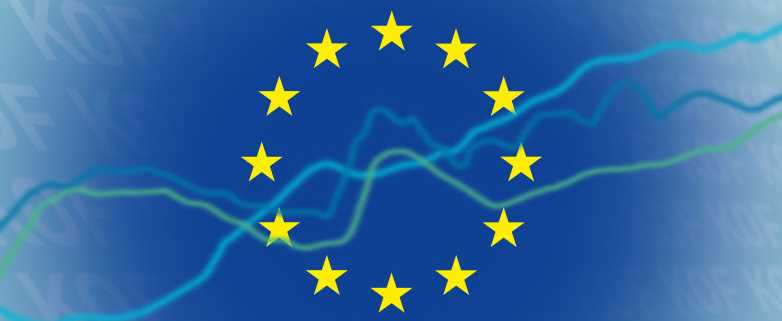Eurozone on the Fast Lane
- KOF Bulletin
- World Economy
In the past year, macroeconomic production in the eurozone expanded by 1.7%, giving Europe a growth edge over the USA for the first time since 2008.

Among the bigger countries, economic expansion accelerated particularly in Germany (1.8%), Spain (3.2%) and the Netherlands (2.1%). However, even smaller countries in Central and Eastern Europe, especially Romania, Bulgaria and Slovakia, recorded significant growth. In the wake of Spain’s performance, the Portuguese economy also picked up speed in the second half of the year. Similarly, macroeconomic production expanded in the Baltic states. In contrast, Italy (1%) and France (1.1%), two economic heavyweights, failed to gather momentum. The Greek economy stagnated due to low investor confidence and uncertainty regarding the further development of the international bailout programmes.
The broadly-based upswing is also having a positive effect on the labour market: Since its peak in 2013, the eurozone unemployment rate has been on the decline and has recently levelled out at 9.6%. However, the situation is not the same in all member states. While the Czech Republic (3.5%) and Germany (3.9%) recorded the lowest unemployment, rates in Spain (18.4%) and Greece (23%) are still substantially higher than the European average. The labour market situation also improved in France (9.6%) and Italy (12%), albeit at a slow pace.
Due to persistent, substantial overcapacities in the Eurozone, economic pressure on inflation has been low. Core inflation, which excludes the volatile energy and food components and is thus a suitable indicator of economically driven upward trends, is rising very slowly and stood at 0.9 per cent in January.
The substantial rise in energy prices in December did in fact lead to an abrupt increase in eurozone headline inflation. Expressed as the YOY movement of the harmonised consumer price index, this increase amounted to 1.8 per cent in January. At present, inflation is thus more or less consistent with the European Central Bank’s target of just close to, but under two per cent. Once the energy price effects peter out, inflation is likely to decline sharply. The ECB is therefore maintaining its current low-interest policy. Although the volume of its monthly bond purchases will be reduced to 60 billion euros as of April, the buying programme has been extended at least until December 2017.
Favourable outlook for 2017 tainted by political uncertainty
Although some economic indicators are hinting at a slight downturn, the upswing in the eurozone is generally expected to continue. Dynamics face a certain downward risk in the form of the Dutch, French and German general elections (in March, May/June and September, respectively), with fears persisting that anti-EU and anti-immigration parties could make inroads into the electoral bases. This would hold back government formation and might affect the EU’s decision-making ability, for instance in regard of its approach to the Greek debt problem.
Given the quarrels among its governing party, new elections are also in the air in Italy. In KOF’s opinion, Italy is the most likely candidate for political upheaval with a pan-European impact. In the case of an election victory, the MoVimento 5 Stelle protest party intends to offer a referendum on the abolition of the Euro in Italy. Two other major opposition parties are also critical of the joint currency. Just the prospect of a Euro referendum after the elections would be enough to give the financial markets the jitters.
Contacts
- Location location_onLEE G 209
- Phone phone+41 44 632 29 80
- web_asset Detail page
- contactsvCard Download
KOF Konjunkturforschungsstelle
Leonhardstrasse 21
8092
Zürich
Switzerland
- Location location_onLEE G 205
- Phone phone+41 44 632 42 33
- web_asset Detail page
- contactsvCard Download
KOF Konjunkturforschungsstelle
Leonhardstrasse 21
8092
Zürich
Switzerland
No database information available
